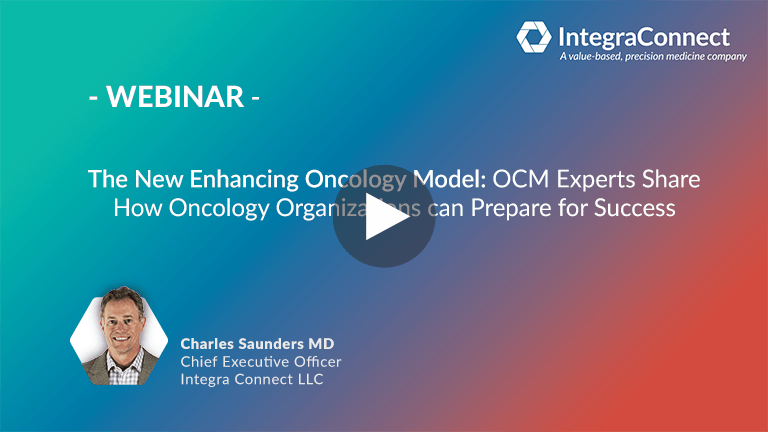The Enhancing Oncology Model (EOM) will begin in July of 2023, giving practices a 12-month runway to prepare for the new value-based care program. Here’s what prospective participants need to do to get ready for success. The time is now.
Dr. Charles Saunders, CEO of Integra Connect
Value-based care (VBC) is experiencing a resurgence after a lull in activities during the COVID-19 pandemic.
Oncology organizations are among the first to benefit from this effort to rebuild momentum, as the Centers for Medicare & Medicaid Services’ (CMS) Center for Medicare & Medicaid Innovation (CMMI) unveiled the next iteration of its value-based care, oncology medical home model for oncology practices – known as Enhancing Oncology Model (EOM).
The new program builds on some of the strengths of its predecessor while making notable adjustments based on industry feedback and results from the OCM program.
EOM generally follows the same structure as OCM, providing Monthly Enhanced Oncology Services (MEOS) payments and retrospective performance-based incentives for certain defined episodes of oncology care.
But it takes person-centered accountable care to the next level with a stronger focus on health equity, expanded use data for decision-making, and a requirement to shoulder some degree of downside financial risk from the very beginning of the program.
These changes, alongside certain alterations to the incentives, the inclusion of regional and national benchmarks, and a narrowing of scope to just seven cancer types, makes EOM a different sort of challenge than the program that came before. It also opens new opportunities for oncology practices that have not worked with value-based care models in the past.
EOM will begin on July 1, 2023, giving prospective participants a full 12 months to get ready for the first performance period. Oncology practices will need to use this time wisely. By conducting a thorough self-assessment, adopting the right technologies, and gaining more visibility into their patients, practices can maximize success with their clinical and financial goals.
Conduct a robust self-assessment of practice capabilities
EOM is more than just an extension program for practices that participated in OCM. It is designed to encourage novice practices to join the value-based care environment, as well.
But not every practice has a clear idea of whether that step is right for them. Oncology groups, including practices, health systems and payers, need to complete a thorough and honest assessment of their current capabilities, future goals, and the gaps in between.
EOM guides oncology practices toward becoming a patient-centered medical home that provides coordinated, holistic care for individuals. For example, practices must collect information on the social determinants of health, offer patient navigation and care coordination services, and make providers available 24/7 in some capacity, among other requirements.
These are new skills for many oncologists and will demand additional staff, health IT tools, and cultural change for the organization.
Before committing to an application, practices should consider creating detailed financial projections incorporating historical financial performance, incentive opportunities and downside risk requirements, and the cost of any additional staffing and technology needs to meet the data-driven criteria of the program.
Implement technology solutions to enable efficient, high-quality care
Technology solutions work best when the implementation process is planned well and executed deliberately. With a full year before EOM begins, oncology-focused organizations should take advantage of this opportunity to optimize performance well in advance of the program’s launch.
If not in place already, organizations should:
- Consider a variety of tools to address the multifaceted criteria of EOM, including platforms to facilitate proactive patient risk stratification, patient engagement and communication, care coordination, financial modeling, and quality performance monitoring.
- Evaluate technologies that deliver information about evidence-based guidelines and appropriate drug substitutions to providers at the point of care to help improve quality and control unnecessary spending.
- Gear-up for the collection and use of social need assessment data and electronic patient reported outcomes (ePRO) data. Practices should develop a strategy to gather and transmit this information in a workflow-friendly manner.
Focus on appropriate HCC coding to support accurate spending targets
Risk coding can be a sensitive subject, especially in value-based care models that pin incentives opportunities to the underlying health status of a patient population. It is essential for practices to use Hierarchical Condition Category (HCC) codes appropriately and accurately to describe their patients’ comorbidities.
CMS will use HCC coding to set target prices for EOM participants and will update the risk profile of the attributed population once per calendar year. Now is the time to carefully examine current coding strategies, close any gaps in documentation, and explore the use of technology tools to augment and automate the risk coding process. Choosing the right implementation partner can not only accelerate EOM initiatives but do it in a way that makes the transformation seem more seamless. EOM is a five-year model, giving oncology organizations plenty of chances to adapt, iterate, and earn incentives throughout the lifetime of the program. However, there is no substitute for a strong start right out of the gate. With ample time to get ready for the start of the model, oncology practices can put themselves on a path to reaping significant benefits from their participation in value-based care.








